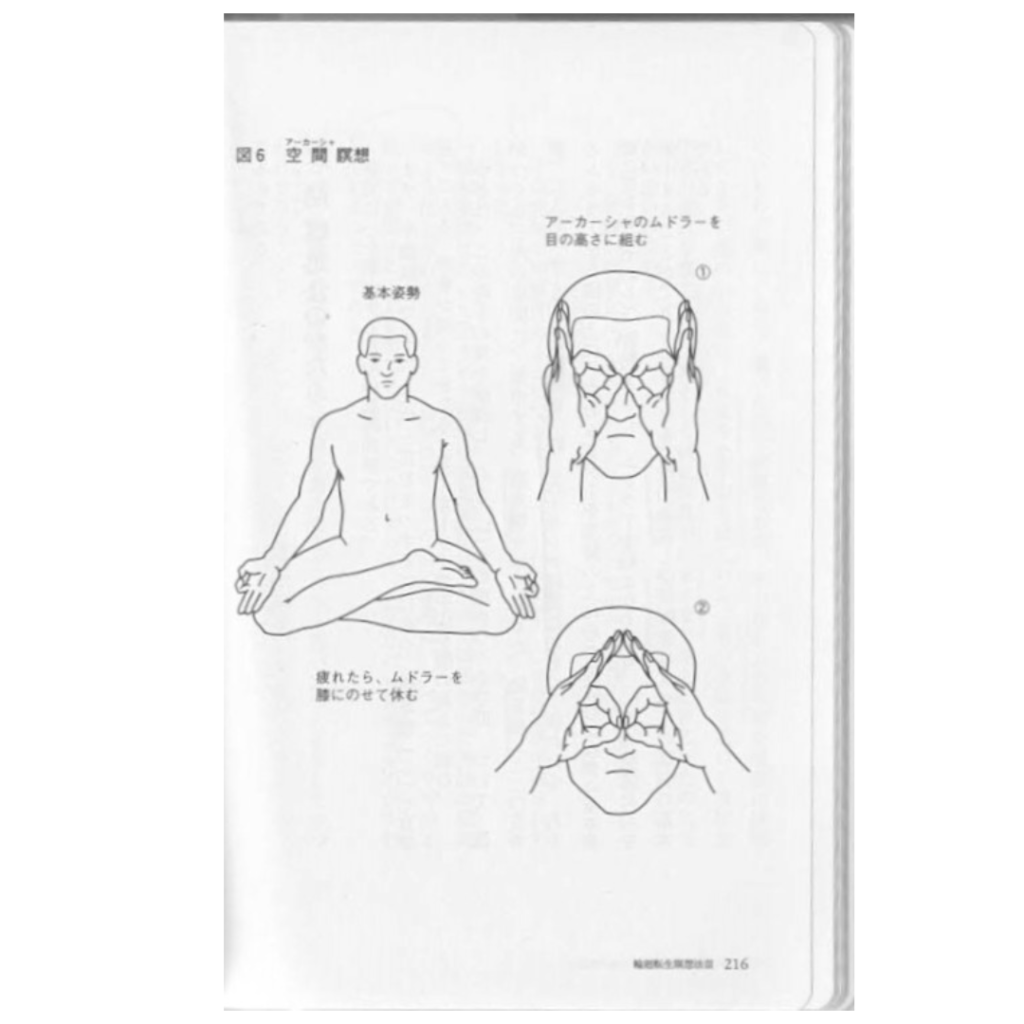さて、いよいよ脳のチャクラの訓練に入るが、その前におこなっておくべ き、いくつかの初歩的な瞑想訓練法を紹介する。
わたくしは、いま 「初歩的な」といったが、これらの訓練法をじっさいにやっ てみると、なかなかむずかしいと感じると思う。
しかしその効果は絶大である。
この章の訓練をみっちりやれば、実生活における、あなたの能力(脳力)は飛 躍的に向上するはずである。 高い集中力を維持したり、常人の想像もつかない飛 躍したインスピレーションを得るといったことが、容易にできるようになるであ ろう。
わたくしも、若いころ、これらの訓練を、仕事の合間や電車に乗っていると きなどに、くり返しおこなったが、その効験は目をみはるものがあった。
最初は少々むずかしいと思うかもしれないが、くり返し練習することによっ て、かならずできるようになるので、しっかりととり組んでいただきたい。
集中(止)と瞑想(観)
では瞑想に入ろう。
坐は半跏趺坐。 坐蒲をもちいる。瞑想の手印を組もう。 これが初歩的瞑想の 基本姿勢である。(図5参照。 ただし、この図では法界定印であるが、後出のアーカー シャムドラーをもちいる場合もある。瞑想の基本姿勢については「輪廻転生瞑想法 II」に、くわしく解説しているので、かならず読んでいただきたい)
瞑想の修行は、二つの領域から成り立つ。
心を集中するとは
ひとつは精神集中法 (concentration)、ひとつは瞑想法 (meditation) である。
これについて少し解説しよう。 まず、シャマタ (止)である。
これは、ひとつのことに心を集中するのである。
数息観がその代表であるが、禅における公案、また、祈りを捧げるとか、経 文を読む、真言を唱えるなども、精神集中法のひとつである。要はひとつのこと
心を集中し、そこに止まり、動かないことである。
この精神集中の状態は二つに分けることができる。
ひとつは「意識的精神集中」で、ひとつのことに意識を集中し、他のものに心 を向けない、これを積極的に意識的におこなうのである。これは修行のはじめの 過程として、だれでも通るものである。
つぎの段階が、「無意識的精神集中」の状態である。これは、高度のもので、 意識的精神集中をつづけているうちに、習練によって条件づけられ、ついに、と くに意識しないでもひとつのことに心を集中することができるようになる。
これによって無意識の意識層をコントロールし、ふつうでは絶対に統御でき ない無意識の意識を、ある特定の対象に向けることができるようになるのであ
心の流れにまかせるとは
つぎに、ビパシャナ(観)である。
これは、ひとつのことに注意をとどめない。心の動きのひとつひとつに心を 向けていくが、ひとつのことにとどまっていない。心の流れにまかせるのであ る。
これにも、「意識的瞑想」 と 「無意識的瞑想」がある。
「意識的瞑想」 は、表面意識が心の流れを観ている。
「無意識的瞑想」は、深層意識の心の流れそのものになっている。
では、その深層意識の流れを観ているものはなにか? だれが深層意識の流 れを観ているのか? それは「無意識的精神集中」の心である。
だから、「止」と「観」は密接な関係があるのである。いまおこなわれている 瞑想のほとんどは、「止」か「観」か、どちらかにかたよっている。禅は「止」 にウエイトがかかり、瞑想(としてやっているもの)は、「観」が主である。 しか
し、「止」を完成した「観」でなければほんとうの瞑想ではなく、「止」でとど まって「観」に入らない定は、これまたほんとうの瞑想ではないのである。 「止」と「観」はおなじように修せられなければならない。そうして、非常に 高度の瞑想(親)をするためには、おなじように非常に高度の集中(止)が体得 されていなければ不可能なのである。
では「意識的瞑想」 と 「無意識的瞑想」 とはどうちがうのか?
ひと口でいうならば、
意識的瞑想は「個の世界」を観
無意識的瞑想は「全の世界」を観る。
といったらよいであろう。
意識的瞑想は「自分だけの世界の流れ」を観るのである。
無意識的瞑想は「人類そのものの(世界の) 流れ」を観るのである。いや、 もっと拡大した世界だ。 「宇宙そのものの流れを観る」といったらよいであろう。
無意識の意識層には、原初からの人類の記憶がすべておさめられている。いや、人類以前からの記憶がすべて秘められている。
わたくしは、「輪廻転生瞑想法I」で、このことについてのべている。「個体発
発生」の意識と記憶について語った第二章を、もう一度読み返して
みていただきたい。
無意識の意識層には、人間が人間以前であった時代からの記憶が秘められて いる。 宇宙生成以来の記憶がそこにあるのだ。 その記憶の流れを如実に観るの である、最高度の瞑想は釈尊の瞑想がそれであった。
「輪廻転生瞑想法II」で紹介したが、もう一度、釈尊の瞑想を見ていただこう。 釈尊はこう語っている。
わたしの心は、一点のけがれもなく、清く明るく、絶対不動 そのとき、
これは、「無意識的精神集中」の最高度の段階に入ったことを示す「止」の極「そしてわたしの心の眼はおのずから前世の光景に向けられていった」
「無意識的瞑想」に入ったのである。
「それは一生だけではなく、二生、三生、十生、二十生、そして無限の生涯 生きかわり死にかわりした光景が展開してきた」
せつな コアセルベート こころ
十生 二十生どころか、人間以前であったころの光景だって展開してくるの である。地球ができたばかりの原始の海で発生した刹那の原形質の記憶だって よみがえらせうるのだ。コアセルベートの目に、できたばかりの地球はどのよ うに映ったであろうか? それを、釈尊は(そしてわれわれも) 観ることができ るのである。
「それからわたしの心は、あらゆる衆生の相に向けられてきた。わたしは超人 的な眼力でその相を見た。そこには貴いもの、しいもの、美しいもの、醜い もの、幸福なもの、不幸なものの、それぞれの宿業が渦巻いていた」
彼は、無限にもひとしい時間を進化してきた。その間、彼は、貴いもの、賤あるのである。
しいもの、美しいもの、醜いもの、幸福なもの、不幸なものの生涯を無数に経験 してきた。彼の心の眼は、もはや全宇宙を観ている。業の法則を通じて彼は全 宇宙の流れを観ている。 おそらく彼は世界の終末までを見とどけていたのにち がいないのである。
釈尊の瞑想とは、まさにこういうものだったのである。
この境地を理解することのできない人たちによって、この瞑想法は消されて しまった。
根本聖典において語られた釈尊の瞑想体験は、すべて誇張された神話伝説 のようにとられてしまった。自分の至りえぬ高い境地は、すべてつくりものと 思って非難することしかできない人たちによって、こんなにも貴重なものが失わ れてしまったのである。
なぜ、釈尊の言葉を信じて、釈尊のあとをたどろうと思い立つことをしなかっ たのであろうか?しかし、わたくしたちは、いま、そのあとをたどりつつ
空間瞑想法のかたち

空間に心を集中するための基礎訓練である。
まず、半跏趺坐で坐る。 上体と首をまっすぐにたもつ。数息観(二一七頁参 照)に入る。呼吸が闘ってきたら、アーカーシャの手印を眼の高さに組む。
つぎに、この両手の環を凝視し、心を、二つの環がつくる空間、ついで、指 がつくる三角の空間に、集中する。数息観をつづけるか、随息観(二〇頁参 照)に入る。手と眼との間隔は、四、五十センチ程度にたもつ。疲れたら、右手 のムドラーを右膝の上に、左のムドラーを左膝の上にのせて休む (瞑想の基本姿 勢に戻るわけである)。習熟すると、ムドラーを組まなくても、一定の空間に心を 集中することができるようになる。空間凝視と空間瞑想はすべての瞑想の基本 である。
Meditation training method to dramatically improve your abilities
Now, we will finally move on to training the brain chakras, but before that we will introduce some basic meditation training methods that you should practice.
I have just called it ``elementary,'' but I think that if you actually try these training methods, you will find them quite difficult.
However, the effect is enormous.
If you follow the training in this chapter thoroughly, your abilities (brain power) in real life will improve dramatically. You will be able to easily maintain a high level of concentration and gain inspiration that is beyond the imagination of ordinary people.
When I was young, I repeated these exercises during breaks at work or when I was riding the train, and the effects were astounding.
It may seem a little difficult at first, but with repeated practice, you will definitely be able to do it, so please work hard on it.
Concentration (stopping) and meditation (watching)
Let's get into meditation.
Sitting in half-prone position. I use a zafu. Make meditation hand signs. This is the basic posture of beginner meditation. (See Figure 5. However, in this diagram it is the Dharma Seal, but in some cases Akar's Shamudra, which will be mentioned later, is also used. The basic posture of meditation is explained in detail in ``Reincarnation Meditation Method II''. (There are many, so please be sure to read it)
Meditation practice consists of two areas.
What does it mean to concentrate?
One is concentration, and the other is meditation.
Let me explain this a little bit. First, there is shamatha (stop).
This concentrates your mind on one thing.
A representative example of this is the idea of number of breaths, but koans in Zen, as well as offering prayers, reading sutras, and chanting mantras are other methods of mental concentration. The point is one thing
Concentrate your mind, stay there, and don't move.
This state of mental concentration can be divided into two types.
One is ``conscious mental concentration,'' which involves concentrating on one thing and not paying attention to anything else, and doing this actively and consciously. This is the first step in training that anyone can go through.
The next stage is a state of ``unconscious mental concentration.'' This is a highly advanced skill that, as one continues to concentrate consciously, becomes conditioned through practice until one is able to concentrate on one thing without being conscious of it.
This allows us to control the unconscious conscious layer and direct the unconscious consciousness, which normally cannot be completely controlled, towards a specific object.
What does it mean to let your heart flow?
Next is Vipasyana (viewing).
This doesn't stop you from paying attention to one thing. You direct your mind to each movement of your mind, but you don't stop at one thing. Let your heart flow.
This also includes ``conscious meditation'' and ``unconscious meditation.''
``Conscious meditation'' involves the surface consciousness observing the flow of the mind.
``Unconscious meditation'' is the flow of the deep conscious mind itself.
So, what is watching the flow of deep consciousness? Who is watching the flow of deep consciousness? It is the mind of ``unconscious mental concentration.''
Therefore, ``stop'' and ``kan'' are closely related. Most of the meditations practiced today are either ``stopping'' or ``watching.'' In Zen, emphasis is placed on ``stopping,'' and in meditation, ``viewing'' is the main focus. deer
However, if it is not ``viewing'' that has completed ``stopping,'' it is not true meditation, and meditation in which he does not enter ``viewing'' at ``stopping'' is also not true meditation. ``Stop'' and ``view'' must be cultivated in the same way. In order to achieve a very high level of meditation (parenthood), it is also impossible to achieve a very high level of concentration (stopping).
So, what is the difference between “conscious meditation” and “unconscious meditation”?
In a nutshell,
Conscious meditation allows you to see the “individual world”
Unconscious meditation sees "the whole world."
It would be good to say.
Conscious meditation allows you to see ``the flow of your own world.''
Unconscious meditation sees ``the flow of humanity itself (of the world)''. No, it's a more expanded world. It would be better to say, ``observe the flow of the universe itself.''
The unconscious layer of consciousness contains all of humanity's memories from the beginning. No, all of the memories from before humanity are hidden there.
I write about this in ``Reincarnation Meditation Method I''. “Individual origin
Re-read Chapter 2, which talks about consciousness and memory in "Generation".
I would like you to see it.
He is hidden in his unconscious layer of consciousness from a time when humans were pre-human. The memories from the creation of the universe are there. He was the one who clearly saw the flow of memory, and the highest level of meditation was that of Shakyamuni Buddha.
I introduced it in "Reincarnation Meditation Method II," but let's take a look at Shakyamuni's meditation again. The Buddha says:
My heart is immaculate, pure and bright, and absolutely steadfast.At that time,
This is the ultimate stage of ``stopping,'' indicating that we have entered the highest stage of ``unconscious mental concentration.'' ``And my mind's eyes naturally turned to the scene of my previous life.''
I entered into ``unconscious meditation.''
``It wasn't just one lifetime, but two, three, ten, twenty, and endless lifetimes, scenes of life and death unfolding.''
Setsuna Coacervate Kokoro
Scenes from the pre-human era are unfolding, let alone ten or twenty years old. He can even revive the memory of the ephemeral protoplasm that arose in the primordial ocean when the earth was just formed. To Coacervate's eyes, how did the newly formed Earth look like a sea urchin? That's what Shakyamuni Buddha (and we) can see.
"Since then, my heart has been directed toward the aspects of all sentient beings. I have seen them with superhuman powers of vision. There are things precious, beautiful, beautiful, ugly, and happy. Although they were unfortunate, their own karma was swirling around them.''
He has evolved over an infinite amount of time. Meanwhile, he is both precious and lowly.
He has lived countless lives, the beautiful, the ugly, the happy, and the unhappy. His mind's eye can now see the entire universe. Through the law of karma, he sees the flow of the entire universe. Perhaps he saw through to the end of the world, and then he died.
This is exactly what Buddha's meditation was like.
This method of meditation has been erased by those who cannot understand this state.
All of the Buddha's meditative experiences described in the fundamental scriptures have been interpreted as exaggerated myths and legends. Something so precious has been lost to people who can only criticize the heights they have reached, thinking that they are all fabrications.
Why didn't he believe in the words of Shakyamuni and set out to follow in his footsteps?However, we are now following in his footsteps.
Form of spatial meditation
This is basic training for concentrating your mind on space.
First, sit in a half-prostrate position. Keep your upper body and neck straight. Enter the number breath view (see page 217). When your breathing begins to struggle, place the Akasha hand sign at eye level.
Next, stare at the rings on both hands, and concentrate your mind on the space created by the two rings, and then on the triangular space created by your fingers. Continue with several breathing techniques or enter suisokukan (see page 20). The distance between your hands and eyes should be about 40 to 50 centimeters. When you feel tired, rest by placing your right mudra on your right knee and your left mudra on your left knee (returning to the basic meditation position). Once you have mastered it, you will be able to concentrate your mind on a certain space without forming mudras. Spatial gaze and spatial meditation are the basis of all meditation.
【このカテゴリーの最新記事】
-
no image
-
no image
-
no image
-
no image





